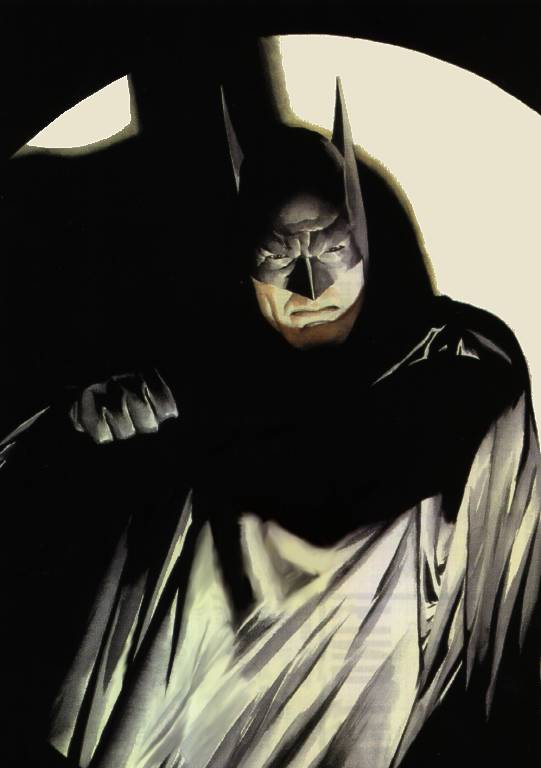 It's a Great Time to Love Cartoons
It's a Great Time to Love CartoonsNever before in history have comics/cartoons/animation been regarded as much a part of American artistic tradition as they are right now.
Whether it be the film projects of Pixar, the comic books of Frank Miller and Alex Ross or the web artists such as Sam Fout, the world of exposure has never been greater for comic artists, and their medium has never been granted this amount of artistic validity.
Part of the reason is Hollywood's realization that great stories make great movies, and there are a lot of great stories within the traditions of America's comic book traditions. Whether it is a revival of the Superman franchise or a revitalization of the Batman films, or the popularity of Frank Miller's artistic stylings (Sin City, Batman Begins/Dark Knight, 300) the capabilities and talents of these great artists is seeing the light of day in a way in which it never has had the opportunity to do before.
 For so long cartoons/comics relied exclusively on printed format for exposure and success. Whether it was syndication in newspapers or being picked up by a publishing house, or working for particular animation studios was the only way a comic animator could enjoy any measure of success. And in many respects, the early forms of comic animation/illustration are still viewed as the benchmark to which we all still strive. Artists like Herge, Kelly, Eisner, Avery, Freleng, Disney and Hanna & Barbara crafted such tremendous art forms that it has taken almost seventy years for art form to evolve beyond that first incarnation.
For so long cartoons/comics relied exclusively on printed format for exposure and success. Whether it was syndication in newspapers or being picked up by a publishing house, or working for particular animation studios was the only way a comic animator could enjoy any measure of success. And in many respects, the early forms of comic animation/illustration are still viewed as the benchmark to which we all still strive. Artists like Herge, Kelly, Eisner, Avery, Freleng, Disney and Hanna & Barbara crafted such tremendous art forms that it has taken almost seventy years for art form to evolve beyond that first incarnation.In my opinion, two things have contributed to this change in the world cartoons.
1) The Internet caused a revolution for the world in countless ways. For the artist, it created an opportunity for even the most unheard obscure comic to have its moment in the spotlight. As a result, many artists subsist entirely on web-based comics and animations.
Artists like Sam Fout (top illustration) create entire worlds of creatures that would probably not find any sort of audience in mainstream publication. But as a web-comic, these stories find precisely the audience that they are intended for. Also, the internet has raised awareness a thousand fold, creating and strengthening communities of like-minded artists and comic enthusiasts who may have
 otherwise never have met.
otherwise never have met.2)Baby Boomers Grew Up
I regard this as the far more significant development of the two key points of reason.
Prior to World War II, there were only a handful of comic book creations (Seigel & Schuster's Superman) and well-known newspaper comic strips. In the late 1920's, Walt Disney began to realize his dream of animation that would capture the imagination of America, but these ideas would not really begin to bear fruit until the next generation of artists began to mature.
Within the next thirty years we experienced the explosion of the feature animated film from Disney studios, as well as the legendary work from the Warner Brothers' studios.
 Comic books enjoyed what historians now refer to as its "golden age," which saw the birth of such characters as Spiderman, the Incredible Hulk, the X-men, Captain America, Batman and the Silver Surfer.
Comic books enjoyed what historians now refer to as its "golden age," which saw the birth of such characters as Spiderman, the Incredible Hulk, the X-men, Captain America, Batman and the Silver Surfer.The children of this generation had the unparalleled privilege of growing up in the shadows of these great charaters, both in the theater and at home on their television, and in their newspapers and newstands.
The fundamental difference between the generations before them is that while cartoons had been regarded as "children's entertainment" and little more to their parents, baby boomers regarded comics as something more, and saw them for the art form they could become.

My generation grew up with the enjoyment of Saturday morning cartoons, (the Smurfs, the Gummi Bears) and now-legendary cartoon strips (Watterson, Larsen and Davis,) but something else happened.
Not only did a renaissance of animation and cartooning occur, but an explosion of creative ideas. No longer was it just about a cartoon strip or an 8-minute short. Artists began using computers and film and ink in ways that hadn't been done yet. The internet allowed artists to see the work of other artists on the other side of the globe. Cartoon art became fused with traditional artistic expression, destroying any idea that comics were only "children's entertainment."
More recently, the success of film studios like Pixar and Dreamworks have brought a new appreciation for cartoons, creating such beautiful scenes, creatures and (most importantly) stories that both kids and adults will enjoy.
This trend doesn't show any sign of slowing down. In fact, it's amazing to think of where the art form could go within the next five, ten and fifteen years. As the form becomes more accessible, more people will have the opportunity to create. And while this will create more schlock than ever before, the talented artists will be discovered, and hopefully allowed to create something truly unique.
No comments:
Post a Comment